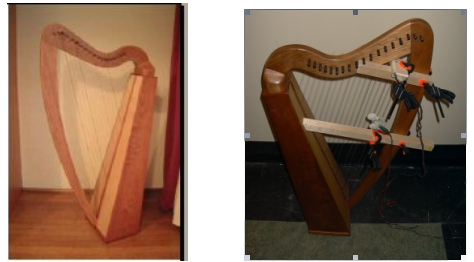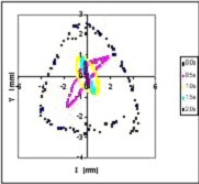ASA/CAA '05 Meeting, Vancouver, BC



Motion of Harp Strings
Gary Chan - gakachan@interchange.ubc.ca
Chris Waltham
University of British Columbia
Department of Physics and Astronomy
6224 Agriculture Road
Vancouver, B.C. V6Y 1Z1
Popular version of paper 5aMU9
Presented Friday morning, May 20, 2005
Joint ASA/CAA Meeting, Vancouver, BC
A harp is a musical instrument that has been somewhat neglected from scientific
research. We want to better understand how the harp is able to produce its distinctive
sound from the mere pluck of a string. This involves examining the interaction
between the strings and the sound board of the harp. In particular, we have
taken a detailed look at the motion of plucked harp strings.

We set up two optical sensors around the string to measure the position of the string. Once we have calibrated the sensors properly, we then plucked the string and collected data on the string motion. Our results show that the movement of a plucked string is more complicated than one might suspect. We found that certain features in the string's trajectory would arise depending on the string's location on the sound board. For example, if the string happens to be at a resonant frequency of the soundboard, its motion would consist of opening and closing ellipses. Other strings only moved in ellipses that would shrink and decay only. Furthermore, we noticed that other features would appear constantly, regardless of which string was plucked. An example of this would be the change in the string's rotation direction. After the pluck, every string would start out circling in one direction, and at some point, it would turn around and continue rotating in the opposite direction.

We then explained the nature of the string's behavior by reproducing the motion using a simulation. We modeled the string and sound board system with a simple coupled oscillator and ran the simulation. By comparing the numerical results with the observed ones, we were able to verify that the string and sound board interaction alone caused several features of the observed string motion. For instance, both the collapsing and expanding ellipses and the change in rotation direction already described were recreated with this simple model. However, other fine details in the string motion were not accounted for in this simple model.
In sum, our experiment revealed the basic features of the motion of a plucked harp string. Some of the key features were caused by the coupled oscillations between the string and sound board, as we have verified from simulations. The next step would be to study the sound board movement in detail, and then sound radiation from the harp. Then perhaps all these components of the harp can be put together and a complete understanding of harp acoustics may be developed.